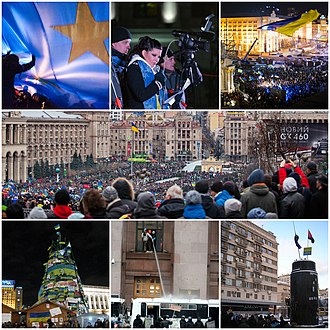Euromaidan

Euromaidan was a wave of demonstrations and civil unrest in Ukraine that began on the night of 21 November 2013 with public protests demanding closer European integration. The protests were sparked by the Ukrainian government's decision to suspend the signing of an association agreement with the European Union, instead choosing closer ties to Russia and the Eurasian Economic Union. The term "Euromaidan" was initially used as a hashtag of Twitter. It quickly became popular in the international media and refers to the main square in the capital, Kyiv, where the protests predominantly took place, "Maidan Nezalezhnosti" (Independence Square).
Background[edit]
The roots of Euromaidan were in the complex history of post-Soviet Ukraine. After gaining independence in 1991, Ukraine found itself at a crossroads between maintaining relations with its eastern neighbor, Russia, and pursuing closer ties with Western Europe. The association agreement with the European Union was seen by many as a step towards European integration, offering prospects for economic growth and the consolidation of a democratic society.
Protests[edit]
The immediate trigger for the protests was the announcement by the government, led by President Viktor Yanukovych, that it was suspending preparations for signing the association agreement with the EU. This decision was seen as a move towards closer ties with Russia and a step away from European integration. The protests started small but quickly grew in size and intensity, especially after a violent crackdown by police on peaceful protesters on 30 November 2013. This event galvanized public support for the Euromaidan movement, leading to mass rallies and the occupation of public spaces in Kyiv and other cities across Ukraine.
Demands and Goals[edit]
The demands of the Euromaidan protesters evolved over time. Initially, they called for the resignation of the government and the signing of the EU association agreement. However, as the movement grew, the demands expanded to include calls for constitutional reform, a crackdown on corruption, and the protection of human rights and freedoms.
Government Response[edit]
The government's response to the Euromaidan protests was initially conciliatory, but it quickly became repressive. Riot police were used to disperse crowds, resulting in numerous injuries among protesters. The situation escalated in February 2014, leading to violent clashes between protesters and security forces, with dozens of people killed and hundreds injured.
Outcome[edit]
The Euromaidan protests resulted in significant political changes in Ukraine. President Yanukovych fled the country in late February 2014, and a new government, supportive of European integration, was established. The movement also sparked a broader discussion about national identity, sovereignty, and Ukraine's future direction.
Legacy[edit]
Euromaidan has left a lasting legacy in Ukraine and beyond. It demonstrated the power of civic activism and the desire of the Ukrainian people for democratic governance and European integration. The events also strained relations between Russia and the West, contributing to the subsequent annexation of Crimea by Russia and the conflict in Eastern Ukraine.
Ad. Transform your life with W8MD's Budget GLP-1 injections from $75


W8MD offers a medical weight loss program to lose weight in Philadelphia. Our physician-supervised medical weight loss provides:
- Weight loss injections in NYC (generic and brand names):
- Zepbound / Mounjaro, Wegovy / Ozempic, Saxenda
- Most insurances accepted or discounted self-pay rates. We will obtain insurance prior authorizations if needed.
- Generic GLP1 weight loss injections from $75 for the starting dose.
- Also offer prescription weight loss medications including Phentermine, Qsymia, Diethylpropion, Contrave etc.
NYC weight loss doctor appointmentsNYC weight loss doctor appointments
Start your NYC weight loss journey today at our NYC medical weight loss and Philadelphia medical weight loss clinics.
- Call 718-946-5500 to lose weight in NYC or for medical weight loss in Philadelphia 215-676-2334.
- Tags:NYC medical weight loss, Philadelphia lose weight Zepbound NYC, Budget GLP1 weight loss injections, Wegovy Philadelphia, Wegovy NYC, Philadelphia medical weight loss, Brookly weight loss and Wegovy NYC
|
WikiMD's Wellness Encyclopedia |
| Let Food Be Thy Medicine Medicine Thy Food - Hippocrates |
Medical Disclaimer: WikiMD is not a substitute for professional medical advice. The information on WikiMD is provided as an information resource only, may be incorrect, outdated or misleading, and is not to be used or relied on for any diagnostic or treatment purposes. Please consult your health care provider before making any healthcare decisions or for guidance about a specific medical condition. WikiMD expressly disclaims responsibility, and shall have no liability, for any damages, loss, injury, or liability whatsoever suffered as a result of your reliance on the information contained in this site. By visiting this site you agree to the foregoing terms and conditions, which may from time to time be changed or supplemented by WikiMD. If you do not agree to the foregoing terms and conditions, you should not enter or use this site. See full disclaimer.
Credits:Most images are courtesy of Wikimedia commons, and templates, categories Wikipedia, licensed under CC BY SA or similar.
Translate this page: - East Asian
中文,
日本,
한국어,
South Asian
हिन्दी,
தமிழ்,
తెలుగు,
Urdu,
ಕನ್ನಡ,
Southeast Asian
Indonesian,
Vietnamese,
Thai,
မြန်မာဘာသာ,
বাংলা
European
español,
Deutsch,
français,
Greek,
português do Brasil,
polski,
română,
русский,
Nederlands,
norsk,
svenska,
suomi,
Italian
Middle Eastern & African
عربى,
Turkish,
Persian,
Hebrew,
Afrikaans,
isiZulu,
Kiswahili,
Other
Bulgarian,
Hungarian,
Czech,
Swedish,
മലയാളം,
मराठी,
ਪੰਜਾਬੀ,
ગુજરાતી,
Portuguese,
Ukrainian
